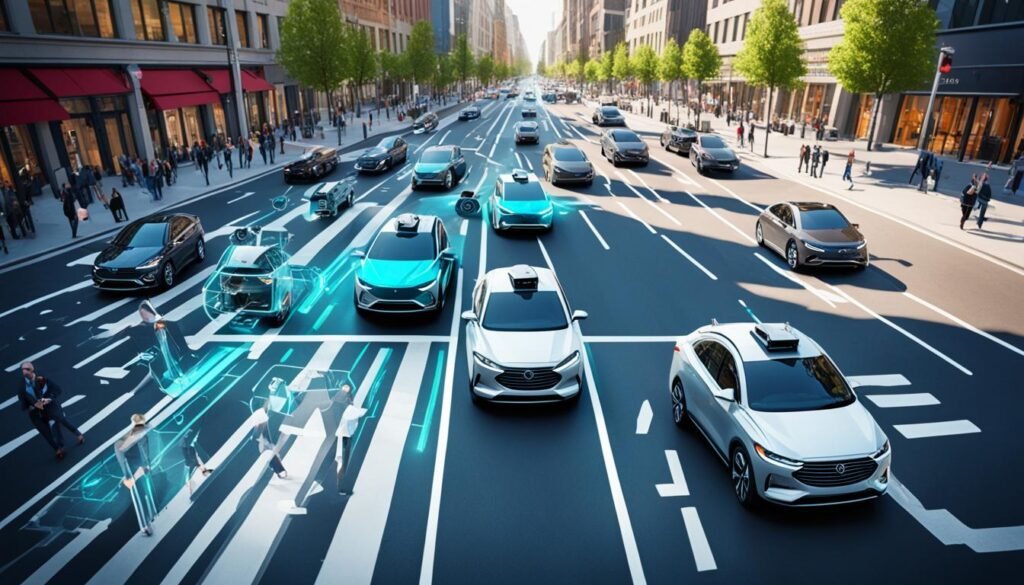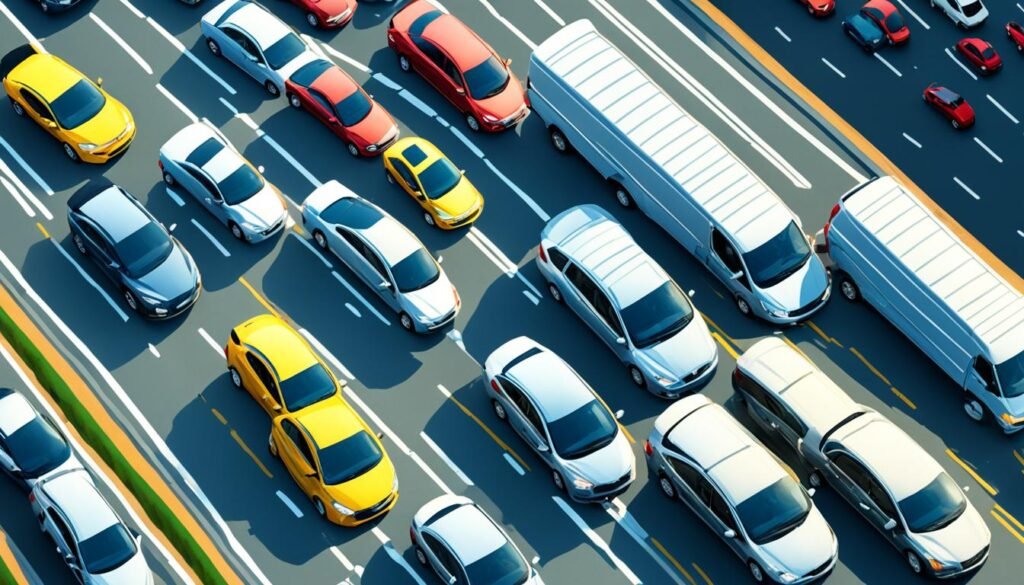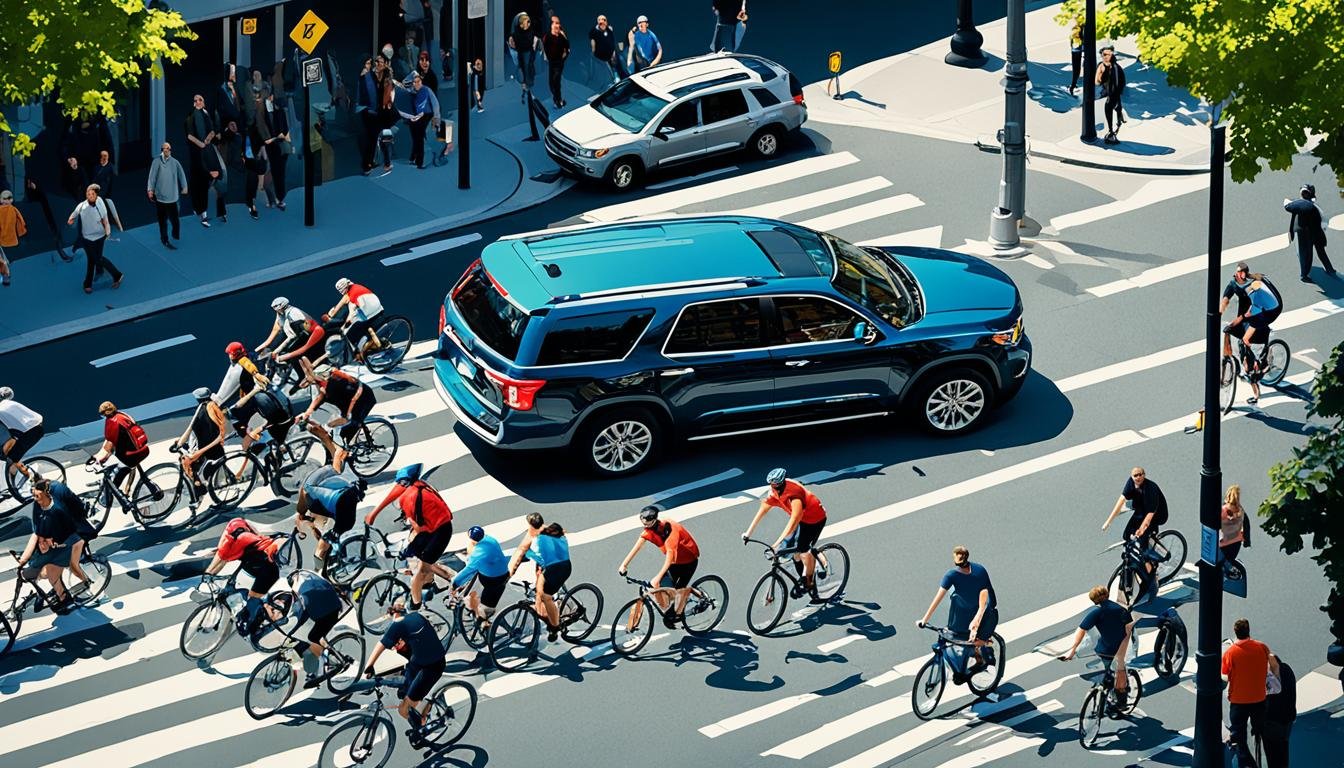Did you know that in 2019, the U.S. saw 6,205 pedestrian deaths? This number is 51% higher than the lowest count in 2009. This rise shows the danger that bigger vehicles pose to pedestrians.
As cars get bigger, pedestrians face more risks. Trucks and SUVs are more popular but riskier for those walking. This, along with poor pedestrian safety and car-focused city plans, causes more accidents.
We need to tackle this issue for pedestrian safety. Understanding why big cars are popular can help. So can better safety steps for traffic. This can make roads safer for all.
Key Takeaways:
- The supersizing of vehicles has led to a 51% increase in pedestrian deaths since 2009.
- The popularity of larger vehicles, such as trucks and SUVs, poses a greater risk to pedestrians.
- The lack of pedestrian safety measures and urban planning considerations contribute to the rising number of accidents.
- Addressing this issue requires understanding the reasons behind the popularity of larger vehicles and implementing effective traffic safety measures.
- Prioritizing pedestrian safety and considering the implications of vehicle size in urban planning is crucial for creating safer cities.
The Reason behind Large Vehicles’ Popularity
Many people love big cars for a few reasons. These cars have more room for stuff and look powerful. This makes them great for work or fun trips that need extra space.
Feeling safe is another big reason why people choose larger vehicles. Many think that bigger cars protect them better if there’s an accident. This feeling makes trucks very popular among those who value safety.
Looking back, big cars have been a sign of success since after World War II. They showed off America’s wealth and freedom-loving spirit. Today, big cars still symbolize status and freedom for many.
Even as sedans lose favor, big cars like SUVs and trucks are more popular than ever. Car makers have noticed. They now offer many types of big, stylish cars.
Knowing why big cars are popular helps us tackle safety issues better. We can work towards roads that are safe for everyone.
Pedestrian Safety Measures
In Europe, governments have acted faster on pedestrian safety than in the U.S. They’ve set up strict rules and standards. These standards aim to lower accidents and injuries that pedestrians face.
The European New Car Assessment Program (encap.com) now includes pedestrian safety in their reviews. This means cars are rated on how safely they interact with people, not just those inside the vehicle.
The European New Car Assessment Program (Euro NCAP) conducts a series of crash tests to assess vehicle safety. They evaluate different aspects, including adult occupant protection, child occupant protection, pedestrian protection, and safety assist technologies. By including pedestrian protection as a crucial evaluation criterion, Euro NCAP promotes the development and implementation of pedestrian safety technologies.
Self-driving car tech could also make walking safer. These vehicles use sophisticated tech to see and steer clear of pedestrians. This could lower accidents caused by human mistakes.
While we wait for self-driving cars to become common, everyone can take steps to avoid accidents.
- Make eye contact with drivers before crossing the road.
- Wear bright and visible clothing, especially in low-light conditions.
- Always use designated crosswalks or pedestrian walkways.
- If there is no sidewalk available, walk against traffic to enhance visibility.
By using these safety strategies, we can all help create safer cities.

Comparison of Pedestrian Safety Regulations in Europe and the United States
| Category | Europe | United States |
|---|---|---|
| Pedestrian Safety Regulations | Strict regulations and European safety standards are in place to protect pedestrians. | Regulations are less comprehensive and have been slower to address pedestrian safety concerns. |
| Pedestrian Safety Ratings | The European New Car Assessment Program (Euro NCAP) includes pedestrian safety ratings as part of a vehicle’s overall safety rating. | No mandatory pedestrian safety ratings are required for vehicles in the United States. |
| Autonomous Vehicle Technology | European countries are actively developing and implementing autonomous vehicle technology to enhance pedestrian safety. | The United States is also working on autonomous vehicle technology, but widespread implementation is still in progress. |
The Role of Vehicle Size in Pedestrian Accidents
Recent studies show how big vehicles affect pedestrian deaths. The research looks at crashes recorded by the National Highway Traffic Safety Administration. It turns out, pickup trucks and SUVs are more dangerous for pedestrians than smaller cars. The main reasons are the vehicle’s height and weight.
Pedestrians hit by pickup trucks face a 12.4% chance of dying. For those struck by full-size SUVs, the rate is 11.9%. These statistics underline how serious the problem is. We must tackle it swiftly.
Trucks and SUVs have taller hoods. This makes it more likely for pedestrians to be hit in the head or chest, causing serious injuries. The heavy weight of these vehicles also makes impacts deadlier.
Larger vehicles are causing more pedestrian deaths. We need to think about how we design and regulate them. Looking at the height and weight of vehicles, we can make roads safer for people walking.
Reducing Vehicle Hood Height
Lowering the hood height of vehicles could save lives. It would make injuries less severe if a car hits a pedestrian. Making car makers design cars with lower fronts would help protect people.
Reducing Vehicle Weight
Vehicle weight is also key for pedestrian safety. Heavier cars cause worse injuries. Encouraging lighter materials in cars could make a big difference.
We need a plan that looks at both hood height and vehicle weight. Protecting people should be a key factor in designing cars and making rules. This way, we can cut down on the deaths caused by big vehicles.

| Vehicle Type | Fatality Rate |
|---|---|
| Pickup Trucks | 12.4% |
| Full-Size SUVs | 11.9% |
Conclusion
Big vehicles are causing more accidents with people walking. Their growth in popularity, lack of safety steps and urban planning issues are dangers. It’s critical to put pedestrian safety first and bring in strong traffic safety actions. Also, we need to look at how vehicles are made and the rules around them to protect people better.
We must take broad steps to make walking in cities safer. This means putting in better crosswalks, traffic lights where they’re needed, and making sure pedestrians can be seen. Adding safety features into how cities are planned and built is also key. This helps build safer, lasting communities.
Keeping pedestrians safe demands effort from many groups, including government, city planners, traffic experts, and car companies. Focusing on pedestrian safety when making policies and developing cities is essential. This will protect walkers and lower the sad number of accidents due to very large vehicles.
FAQ
What is causing the rise in pedestrian accidents?
How are vehicle size increases impacting pedestrian safety?
What can be done to improve pedestrian safety?
Are there any safety regulations in place for pedestrians?
How can drivers and pedestrians enhance safety?
Source Links
- https://www.rmdlaw.com/personal-injury-blog/americas-supersizing-of-vehicles-is-causing-more-potential-pedestrian-accidents/
- https://www.wired.com/story/tall-truck-suv-hoods-pedestrian-deaths/
- https://arstechnica.com/cars/2024/01/higher-vehicle-hoods-significantly-increase-pedestrian-deaths-study-finds/

